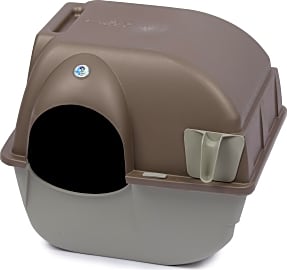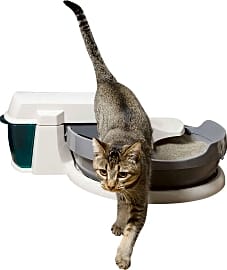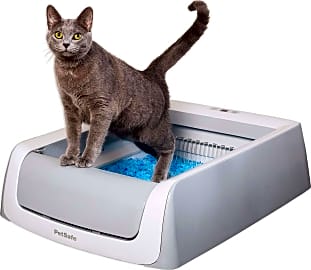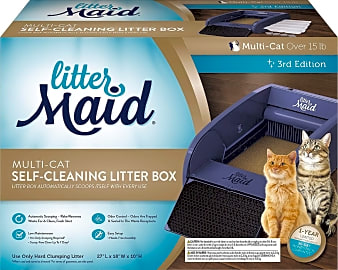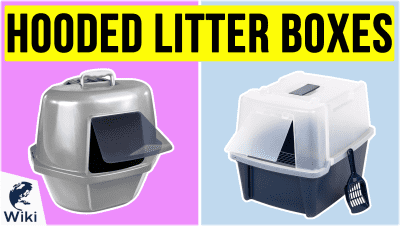The 6 Best Self Cleaning Litter Boxes

This wiki has been updated 41 times since it was first published in April of 2015. Yes, cats are lovely, but their pee and poop are not. Ditch the bad part of owning a feline by using one of these self-cleaning litter boxes to keep your house clean and odor-free. We've included models suitable for multi-cat households as well as futuristic, robotic options. Just keep in mind that most of these still require you to periodically disassemble them for a through washing. When users buy our independently chosen editorial picks, we may earn commissions to help fund the Wiki.
Editor's Notes
November 29, 2020:
The Pet Zone Smart Scoop is off the market, but luckily, the Litter Maid Multi 3.2 is an improvement over the company’s other versions, and we were confident about adding it to the list. We also updated the PetSafe PAL17-10786 to the PetSafe Simply Clean, which is an upgrade of the previous model.
Electronic litter boxes are notoriously finicky, much like cats themselves, so follow directions carefully and be sure to use a cat litter that’s the right match for your model. Also, it’s important to choose a box that’s right for your household; electronic litter boxes can take up more floor space than traditional ones, yet there’s often less room inside for your cat. If you have a multi-cat household, be sure to get a box that cleans after each use, or cleans continuously, and remember that even with the cleaning and maintenance that some electronic boxes require, you’re still saving time by not scooping multiple times a day. If you’re wary of electronic versions, the Omega Paw Roll is a hybrid version that needs no electricity, but makes cleaning easier than with scooping methods.
November 21, 2019:
This round of updates we eliminated the LitterMaid LM980 Mega and the PetSafe Simply Clean, simply because they weren’t reviewing nearly well enough to maintain their ranked position. In the case of the latter, it sounds like most this negative feedback is stemming from a disappointing new edition of the offering, which is too bad since the company clearly seems to be capable of producing a quality product. Perhaps, with a bit more research, development and troubleshooting, the box may be back in the future.
Still, there’s little need for PetSafe to despair, since we replaced our removed rankings with two additional offerings from their company: The PetSafe PAL00-16805, which is essentially an open-air version of the PetSafe ScoopFree, and the PetSafe PAL17-10786 – which got our attention with its innovative removal system.
If you’re on the fence about this purchase, I urge you to give it a shot. Not only is it one the single greatest ways to improve your cat’s lifestyle – rivalled only by investing in a cat house or a grain-free diet for them – but it’s also a great way to alleviate a lot of the pressure that’s put on you by pet maintenance.
If you’re worried about transitioning, don’t be. Just introduce the new box next to their old box and discontinue cleaning of the old depository. It won’t be long before your feline friend moves next door into the new real estate. Once that’s over with, the next thing you’ll be trying to figure out is why it took you so long to make this change.
Troubleshooting Litter Box Problems
Make sure that your cat can easily get in and out of the litter box.
For most cats, using a litter box is instinctual. Cats are naturally inclined to use sand or soil to eliminate, so the litter box is a rather natural domestic compromise. But what does it mean when your cat seemingly abandons these natural instincts, instead eliminating on your Persian carpet? Fortunately, if you're facing any of these problems, we're here to help you troubleshoot what might be leading to your cat's unusual behavior.
Adjustments take time: Imagine using a regular toilet for years, and one day, without explanation, you go to use your toilet only to find that it has been replaced with a high tech bidet. It's still a toilet, of course, but you're not sure how to open the seat, and maybe you're even a bit frightened by the anticipated water action. What is this? How did it get here? Will it hurt me? This is, of course, a bit of a simplification, but may be akin to how your cat feels when you've switched its standard litter box with an automatically self-cleaning litter box. To your cat, this electronic version could appear as a monster, with rakes for teeth and a clunky motor that sounds as though it growls. Can you really be surprised if your cat refuses to so much as approach it? Luckily, there are things you can do to help your cat make the switch.
Foremost, don't expect your cat to quit the old litter box cold turkey. Give kitty a chance to warm up to it by letting her explore this new contraption when you first take it out of the box. Then, set it up next to your cat's old litter box, but don't activate it yet—this gives her a chance to explore it without developing a fear of the loud and surprising electronic components. By having it turned off for several days, your cat will become accustomed to the box itself.
Once a few days have passed, turn the electronic litter box on. Most self-cleaning litter boxes will provide a way to manually turn on the scooping function, so turn this on a couple of times a day to familiarize your cat to the sound it makes. Try to avoid doing this when your cat is right next to it, and especially avoid it when she's using her old cat box. This might catch her off guard and create negative associations.
When your cat no longer seems startled by the box or the sound it makes, add litter to it. If you're switching litter types, try adding a couple scoops of the old litter to the new litter to help your cat make the adjustment. You should only need to do this one or two times.
Leave the old litter box next to the new one, and be sure and praise your cat when she does use the new box. If you remove the old box too quickly—before your cat feels comfortable using the new box—your cat may not use any litter box at all. Yikes! If your cat simply refuses to use the new box, see if you can persuade her to do so by letting the old litter box get dirty (cats can't stand it!). When your cat starts regularly using the new litter box and has done so for a few weeks, take the old litter box away. If your cat still isn't eliminating in the right place, remember not to scold or admonish her—it may worsen the problem and exacerbate her anxiety about using the new box. Try instead to exercise patience and give your cat the time she needs to make the switch.
Medical problems: One reason your cat may stop using the litter box—or refuses to adjust to a new litter box—is because of health problems. If your cat has stopped using the cat box, seems unable to eliminate even when trying to do so, or is spending an unusual amount of time cleaning its genitals, you should immediately take your cat to the vet. These may be signs of a urinary tract infection or a more severe blockage—especially if you have a male cat. Male cats are more susceptible to urinary tract infections and blockages because of their urethras, which are much narrower than female cats' wider urethras. These medical problems are severe and can even be fatal due to toxin buildup if there is a complete blockage, so it's important to make sure your cat's problem isn't medical if it is exhibiting the described symptoms.
Other problems: Other factors may be influencing your cat's willingness to use its litter box, whether it's a standard or self-cleaning one, such as its location, the shape, the type of litter, or its cleanliness. Cats are picky, and something as seemingly insignificant as any of the aforementioned things may be at the root of the problem.
Because troubleshooting the litter box's location will be easiest, start there. Make sure to place the cat box somewhere quiet and private, where they will not be disturbed by loud noises, such as buzzers on appliances, and somewhere that they will not have to cross the path of another pet. Additionally, try to place the litter box in somewhere that gets minimal foot traffic and that does not have a lot of people coming in and out.
Make sure that your cat can easily get in and out of the litter box. Some geriatric cats will need a litter box with a low-walled entrance. Additionally, many cat-owners choose litter boxes that are too small for their cats. According to Petfinder, litter boxes should be at least one and a half times the length of your cat.
Finally, try to scoop the litter box daily. You probably flush every time you use the toilet, so why doesn't your cat deserve the same luxury? It not only keeps the litter cleaner and fresher smelling, but also helps encourage your cat to eliminate in the proper place.
The Science of Cat Feces
A lot of people don't like handling cat litter because being in close proximity to feces is just gross—and who can blame them? But there might be scientific evidence to support the positions of those who want to stay away from cat litter by buying a self-cleaning litter box. By automatically scooping the litter, self-cleaning litter boxes both inhibit parasitic and bacterial growth in feces and ensure a minimal amount of contact between the user and the excrement.
Salmonellosis can cause similar symptoms to those of campylobacteriosis, such as severe diarrhea and cramps.
Research shows that cat feces can, under some circumstances, lead to a variety of parasitic and bacterial infections if not handled properly. Toxoplasma gondii is a parasite excreted in cat feces. Not all cats have the parasite, but they can get a Toxoplasma infection by ingesting infected rodents or the feces of other infected cats. Once infected, a cat can shed the parasite in their feces for up to two weeks.
Although rare, people can become infected with toxoplasmosis in several ways. Among those is through the ingestion of anything that has become contaminated by the feces of infected cats. Those who become infected with toxoplasmosis show either no symptoms or mild illness, but it can have severe effects on fetuses when pregnant women become infected.
Through the unsanitary handling of soiled cat litter, people can also contract bacterial infections such as campylobacteriosis, caused by the Campylobacter bacteria. Campylobacteriosis can cause flu-like symptoms, such as a fever, headache, cramps, or diarrhea. Cats can also become infected with Salmonella bacteria, in which case, the resulting salmonellosis can be transmitted to humans. Salmonellosis can cause similar symptoms to those of campylobacteriosis, such as severe diarrhea and cramps.
While the chances of contracting any of these infections are rare, self-cleaning cat boxes can minimize human contact with potentially dangerous cat feces. Because of this, they might be a particularly advantageous investment for people with diseases that compromise their immune systems and could cause these minor infections to become life-threatening.
History and Design of Self-Cleaning Litter Boxes
When researching self-cleaning litter boxes, you will be surprised to learn that almost none of these products operate the same way. They comprise a unique category of consumer products where each litter box tends to use entirely different technology than the next—unlike, say, your standard toilet, which functions pretty much the same way as any other toilet. Maybe it's an issue of patents, or maybe it's just because no one has figured out the single best way to automatically scoop cat litter. Regardless, this differentiation has led to some pretty innovative designs, which we're going to discuss in the following paragraphs.
History
Many self-cleaning litter boxes have safety mechanisms that are activated when a sensor detects that your cat has entered the box.
The history of self-cleaning litter boxes is brief, because they've only been around since around 1991. It looks like the first design for an automatically cleaning litter box was patented in September 1991 by Angelo Carlisi. Like most of today's models, it suggests using a motor-driven rake to filter the solids out. The design was probably made possible by the invention of clumping cat litter in the 1980s, which made cat litter less messy and easier to filter.
Sensors
Most of today's electronic self-cleaning litter boxes are equipped with a sensor. At its most basic, this sensor is activated when a cat enters or exits the litter box. Usually, there is a pre-programmed time delay that begins when the sensor is activated, and gives the cat an adequate amount of time to finish its business before the scooping action starts. Some of the more complex litter boxes have sensors that even register and adjust to the cat's weight, allowing them to accommodate large and small cats alike.
Rake
To filter out the waste from the clean litter, the majority of cat boxes use an automated rake that sifts the excrement into a waste tray. Some of these litter boxes, such as the Litter Robot, use an ingenious rotating mechanism to do this. The dome-shaped bin itself rotates, moving the litter past a stationary rake. In other models, a rake moves through a rectangular bin, depositing clumps into a waste tray or other receptacle. In some boxes that use this latter mechanism, such as the ScoopFree, the method is enhanced by the usage of crystals that absorb urine and desiccate solids, thus reducing odors and making it less likely that the rake's tines will get clogged. The CatGenie goes one step further, raking solids into a vessel where they are essentially liquefied and disposed into a drain usually leading into the toilet.
Safety mechanism
It may be easy to imagine a horrifying accident in which your curious cat enters the litter box during its cleaning cycle, but fear not, because the engineers have anticipated this and incorporated solutions into their designs. Many self-cleaning litter boxes have safety mechanisms that are activated when a sensor detects that your cat has entered the box. Once activated, the raking mechanism will stop, and the delay timer will reset, giving your cat an adequate amount of time to leave the litter box.



